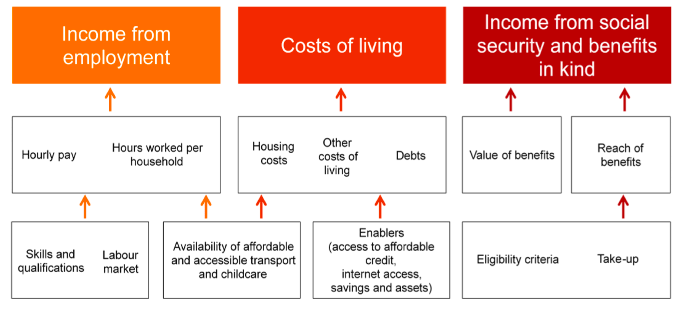Tackling child poverty - fourth year progress report 2021 to 2022: annex A - measurement framework
Measurement framework with the latest data on the drivers of child poverty. The 23 indicators in the child poverty measurement framework are intended to monitor these drivers of poverty. They form part of a wider monitoring and evaluation strategy.
Drivers of child poverty
The drivers of poverty are summarised in the diagram below. These are: income from employment, costs of living, and income from social security and benefits in kind.

The 23 indicators in the Child Poverty Measurement Framework are intended to monitor the drivers of poverty. They form part of a wider monitoring and evaluation strategy.
This annex sets out the trends over time for each of the Child Poverty Measurement framework indicators. Due to the impact of COVID-19 restrictions on the data collection of many national surveys, some indicators could not be updated. Where the data is available and can be trusted to be reliable and robust, new data and trends have been added.
The table below (Table 1) summaries which indicators have been affected by COVID-19 restrictions on data collection.
Summary of issues with latest data collected
Family Resources Survey
Indicators affected: 1: Hourly pay, 3: Hours worked, 12: Housing affordability, 19: Targeted reach of benefits
Issues: The FRS sample for Scotland for 2020/21, did not satisfy official statistics standards. The sample overrepresented people on higher incomes and underrepresented certain groups, such as people in receipt of Universal Credit and lone-parent families. See Family Resources Survey: background information and methodology for further details
Action: Revert to data from previous progress report
Scottish Household Survey
Indicators affected: 8: Childcare affordability
Issues: Methodology Change: Previously only households that indicated they paid for childcare were asked about affordability. In 2020, all parents of 0-11 year olds were asked the same question. The sample therefore includes households eligible for free childcare and is not comparable with previous reporting.
Action: Present new data as distinct from previous years
Indicators affected: 11: Satisfaction with public transport
Issues: Base sample too small to report for low income households.
Action: Revert to data from previous progress report
Indicators affected: 16: Access to affordable credit
Issues: Question asked biennially; not asked in 2020
Action: Revert to data from previous progress report
Indicators affected: 17: No savings
Issues: Question asked biennially; not asked in 2020
Action: Revert to data from previous progress report
Indicators affected: 18: Internet access
Issues: Base sample too small to report for low income households.
Action: Revert to data from previous progress report
Scottish Government attainment statistics
Indicators affected: 7: School-leavers attainment gap
Issues: The COVID-19 pandemic led to the cancellation of exams and external coursework in 2020 and 2021, and alternative approaches to the certification of SQA qualifications were used. This change in certification will have affected the attainment of some school leavers.
Action: Present new data but clarifying where new assessment measures were introduced. Caution when comparing data for 2019/20 and 2020/21 to that from previous years
Housing Condition Survey
Indicators affected: 13: Fuel Affordability
Issues: Survey not carried out in 2020
Action: Revert to previous data
Healthy Living Survey
Indicators affected: 23: Take-up of free school meals
Issues: Question on free school meal take-up not asked as most children were not in school due to the pandemic
Action: Revert to previous data
This is the last progress report where we are using this measurement framework. Going forwards, to report on Best Start, Bright Futures we have an updated measurement framework that includes new and improved data sources.
Contact
Email: tcpu@gov.scot
There is a problem
Thanks for your feedback